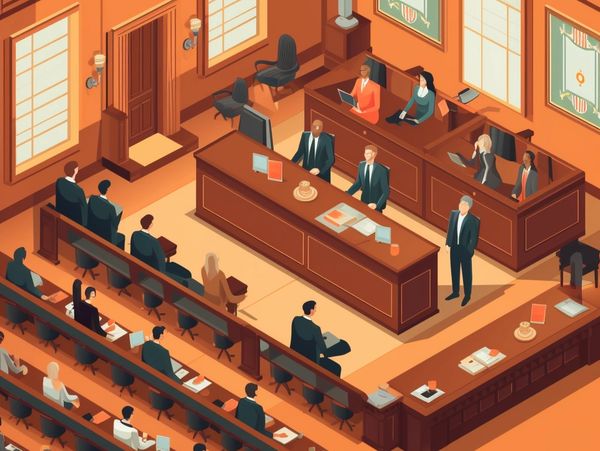Navigating the Intricacies of Trial Presentations: Tips for Seamless Distribution and Compelling Arguments
In the realm of legal process, the art of test presentation stands as a vital component of success. The intricacies inherent in trial presentations call for a fragile equilibrium of ability, skill, and approach.

Understanding Trial Goals
To effectively navigate a test, it is critical to have a clear understanding of the objectives that need to be accomplished. Prior to entering the courtroom, legal teams must define their goals and desired outcomes. These purposes serve as leading principles throughout the trial, forming strategies and affecting decision-making procedures.
Comprehending test goals involves a thorough evaluation of the instance, lawful criteria, and the client's ideal interests. Trial Presentations. It needs a thorough assessment of the truths, determining vital issues, and expecting possible challenges. By establishing measurable and particular goals, attorneys can customize their discussions and disagreements to line up with the desired results
Moreover, a clear grip of test goals allows legal groups to focus on evidence, witnesses, and legal debates properly. It enables for the advancement of a coherent story that reverberates with the discretionary, reinforcing the general case discussion.

Organizing Proof Efficiently
Having a clear understanding of trial objectives lays the foundation for arranging proof efficiently in legal process - Trial Presentations. By straightening the discussion of evidence with the desired end results of the test, legal groups can reinforce their arguments and boost their persuasiveness. One critical element of organizing proof is classification. Grouping proof based upon themes or relevance to details legal elements can aid enhance the presentation and make intricate info more absorbable for the judge or court.
Another crucial element in arranging evidence properly is establishing a sensible flow. Offering evidence in a consecutive and coherent way can aid develop an engaging narrative that sustains the lawful disagreements being made. In addition, using aesthetic help such as timelines, charts, or charts can further improve the company of proof and assist in clearing up intricate connections or series of events.
Additionally, making certain that all evidence provided is permissible and relevant to the instance is necessary. Irrelevant or inadmissible proof can take away from the strength of the argument and potentially damage the integrity of the offering celebration. A meticulous review and selection process ought to be carried out to include only the most legally sound and impactful evidence in the trial discussion.
Crafting Persuasive Stories
Crafting engaging narratives plays a pivotal duty in providing influential disagreements during lawful procedures. When creating a narrative for a trial discussion, it is necessary to establish a clear story that highlights essential factors and links them in a coherent fashion. By weaving together proof, go to these guys testimony, and lawful arguments right into a convincing and natural narrative, lawful professionals can successfully advocate for their customers and enhance the chance of a positive end result in the court.
Understanding Visual Aids
Reliable use aesthetic help is key to improving the influence and clarity of test discussions. Visual aids, when utilized strategically, have the power to simplify intricate information, reinforce crucial factors, and leave a lasting perception on the court and court. To master visual help in test presentations, it is important to make certain that they are clear, succinct, and relevant to the arguments being made.
When integrating aesthetic help, such as graphes, graphs, photos, or timelines, right into a test discussion, it is essential to keep them visually appealing yet professional. The visuals ought to match the verbal disagreements, supplying a graph of the info being gone over without frustrating the target market with unneeded details.
Additionally, experimenting the visual aids in advance is essential to ensure a seamless delivery throughout the test. Acquainting oneself with the material, shifts, and timings of each visual help can aid keep the circulation of the presentation and avoid technical problems that might arise.
Providing Impactful Closing Arguments
A compelling closing debate serves as the end result of a trial discussion, encapsulating the core story and persuading the court and jury in the direction of a favorable choice. Begin by outlining the primary arguments that sustain your customer's setting, stressing why the evidence provided throughout the test supports your story.
Moreover, integrating psychological appeal can additionally strengthen your closing disagreement. By attaching and humanizing the case on a personal degree with the decision-makers, you can stimulate empathy and understanding, influencing their assumption of the realities presented. Furthermore, stating the legal requirements that have to be met for a beneficial judgment can enhance the validity of your position. Eventually, a well-crafted closing debate need to leave a long lasting perception, engaging the court and court to regulation in your client's favor.
Conclusion
Finally, mastering trial presentations involves understanding objectives, organizing evidence, crafting narratives, utilizing aesthetic help, and supplying impactful closing debates. By applying these approaches properly, legal representatives can offer their instance flawlessly and make engaging disagreements in the court. It is her latest blog important to navigate the complexities of test discussions with accuracy and skill to achieve success in lawful process.
By lining up the presentation of evidence with the wanted end results of the test, legal groups can reinforce their disagreements and improve their persuasiveness (Trial Presentations). To master aesthetic help in trial discussions, it is critical to make sure that they are clear, concise, and relevant to the debates being made
An engaging closing argument a fantastic read offers as the conclusion of a trial discussion, enveloping the core narrative and encouraging the judge and jury in the direction of a beneficial decision. Begin by detailing the primary arguments that sustain your client's placement, highlighting why the evidence provided throughout the trial sustains your narrative.In verdict, grasping test presentations entails comprehending objectives, arranging evidence, crafting stories, utilizing aesthetic aids, and providing impactful closing arguments.